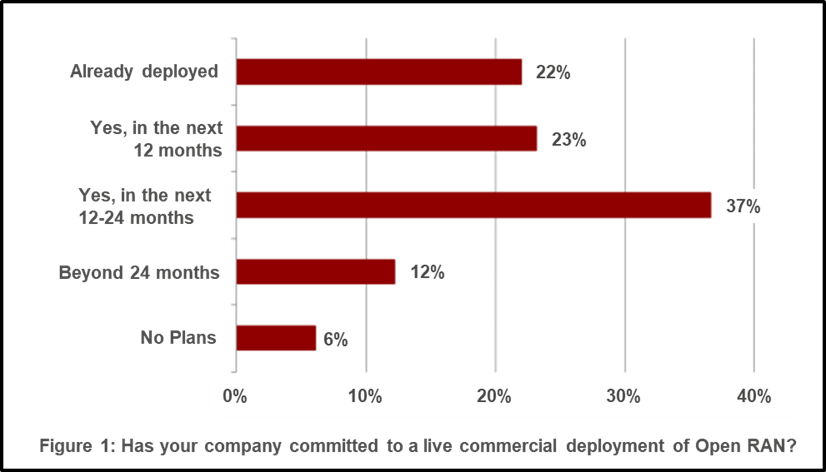The only constant in life is change, and businesses need flexibility to evolve quickly to take advantage of that change. With change comes opportunity, and now more than ever that opportunity extends through the mobile network.
Change can create entirely new industries and will push traditional business models to be reimagined. Consider the past decade, where we have seen the rise of cloud services, artificial intelligence (AI), and a shift to hybrid work. And the mobile network is at the center of much of this change – arguably the most important tool businesses have for facilitating and harnessing the value of change. The newest tool is the fifth generation of mobility (5G) which delivers speed and low-latency for real-time accuracy and improved connectivity – traits that can increase efficiencies and create new business opportunities.
There is another kind of “speed” that is important in 5G and that is the speed that comes with flexibility found in open (non-proprietary) technology. It is well established that open technology can deliver new features faster while driving down costs thanks to a competitive market. (Recall the early days of computing when every system was “unique” and costly). Therefore, the more open we can make the network, the more simple, intuitive, and secure it becomes, and the better off you are to pursue new opportunities. So why would any business lock themselves into a proprietary system that is resistant to change? The answer is simple: they shouldn’t.
This logic extends into what was the last proprietary segment of mobile networks – the radio access network (RAN). Until recently, all RANs were proprietary, locking users into a single vendor and limiting competition that drives faster advancements and lower costs. Fortunately, there is a growing trend to open the RAN. The last five years have seen the rise of the O-RAN Alliance and other partnerships driving and sharing innovations. Several new companies have emerged to offer Open RAN products designed to run on commercial off-the-shelf (COTS) hardware and offer best-of-breed interoperability. Adopters of Open RAN can enjoy agility and flexibility both today and well into the future, allowing businesses to more quickly and cost effectively take advantage of new opportunities.
In fact, a recent survey of global service providers by Heavy Reading has shown that while only 22% of respondents stated their company has already deployed commercially. The report goes on to show that another 60% foresee commercial deployment of Open RAN in the next 24 months (23% of respondents expect commercial deployment within the next 12 months, plus an additional 37% of respondents are looking to commercial deployment in 12-24 months)1.

Cisco
Today, Open RAN is being planned and deployed for both public and private enterprise networks, including public venues, urban densification, and general outdoor macro-RAN deployments. The Heavy Reading survey showed that approximately 57% of respondents plan to use Open RAN for private networks. This report also stated that 57% of respondents plan to deploy Open RAN for venues and other gathering spots1. Open RAN is appealing for the velocity of change it can bring – particularly important for companies looking to gain and maintain competitive edges.

Cisco
Aside from the clear benefits of avoiding vendor lock-in, Open RAN is considered by many to be a more securable solution2. While open products are assumed to have greater vulnerabilities than closed-proprietary products, these open products also have more security tools available. Open RAN solutions are inherently compatible to use a wide range of network infrastructure security products providing visibility, isolation, and threat remediation. Conversely, proprietary solutions can only operate with the limited products made available by that specific vendor (or a close partner). Such limitations expose your business to risks while likely increasing the cost to protect your assets.
And speaking of cost, while proprietary vendors warn that Open RAN could be more expensive, their view is not shared by the majority of the respondents to the Heavy Reading survey which found 57% believe Open RAN offers similar (21%) or greater (37%) total cost of ownership (TCO) savings. Supporting this belief, commercial deployments of Open RAN by Rakuten are proving to deliver greater than 30% Capex and OpEx reduction3. Recently, Cisco and Rakuten Symphony entered into a partnership for software-centric Open RAN-based solutions and a go-to-market model that will help make it even more cost effective, easier, and quicker to adopt Open RAN technologies.
Open RAN is a relatively new and promising shift in technology that is changing the industry’s mindset regarding this network segment. This non-proprietary technology does not sacrifice quality while improving security – and gives businesses the flexibility needed to succeed. Indeed, Open RAN is playing an increasingly important role for evolution of open network standards and for current 5G deployments in both public and private networks. Open technology platforms like this could well become the de facto radio technology as we move into the 6G era and beyond.
We encourage you to learn more about the exciting possibilities and improved TCO that Open RAN provides.
1. https://img.lightreading.com/downloads/whitepapers/2021-Heavy-Reading-Open-RAN-Operator-Survey.pdf?
Read More from This Article: Open Radio Network Deployments Help Ease 5G Economics
Source: News


